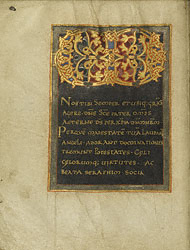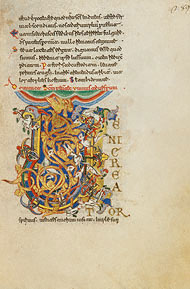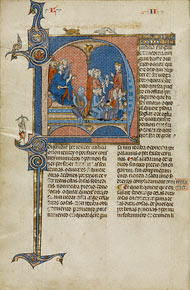| Education | ||
| Exhibitions | ||
| Explore Art | ||
| Research and Conservation | ||
| Bookstore | ||
| Games | ||
| About the J. Paul Getty Museum | ||
| Public Programs | ||
| Museum Home
|
November 13, 2007–January 27, 2008 at the Getty Center
On the pages of medieval manuscripts, vines and luxuriant leaves twist together to create letter forms. Within the letters, fantastic figures of humans, animals, and mythological beasts clamber through the tangled foliage and occasionally transform into letters themselves. Other letters contain simple author portraits or serve as a frame for scenes of important events in a story. This exhibition examines these different letter types in medieval manuscripts and explores what they reveal about changes in manuscript illumination over the course of many centuries. Exuberant foliage decoration within the initial D shown above marks the beginning of Psalm 26, which translated from Latin begins, "The Lord is my light and salvation, whom shall I fear?" The thick acanthus leaves and single bud within the initial, as well as the foliate sprays and pen scrolls in the margins, are typical of late English Gothic manuscript painting. |
||||||||||||||||||||
Ornamented Letters The earliest decorated letters served a practical purpose: to call attention to the beginning of a text or its most important passages. Eventually, artists began to focus their efforts on these initials. Luxurious and ornate foliage patterns glorified the sacred words in books used during church services and in private prayer. |
||||||||||||||||||||
The rounded forms of V and D are joined by a cross with a blue vertical beam to form a ligature, or single unit, in this page from a sacramentary, a a book used during Church services. VD is an abbreviation for "Vere dignum et iustum est" (It is truly fitting and proper), the phrase that began many of the central prayers of the medieval mass. |
||||||||||||||||||||
Inhabited and Figurative Letters Inhabited letters contain humans, animals, or fantastic beasts that climb, crawl through, or spring forth from vegetal forms. Closely related are figurative letters, in which the form of the letter itself is made up of the contorted bodies of people or creatures.
|
||||||||||||||||||||
This combative imagery of this initial H introduces the beginning of the Decretals, a book on church law. A man and a centaur are ensnared in vines that are actually the tails of two serpentine, blue-faced beasts that gaze malevolently at their prey.
|
||||||||||||||||||||
Historiated Letters It is a small step from inhabited or figurative initials enlivened with human and animal forms to historiated letters, which contain scenes or subject matter related to the adjacent text. The contents of these letters range from simple author portraits to complex scenes inspired by a text or narrative.
|
||||||||||||||||||||
A monk engulfed in water clings to the curve of an initial S that begins the first verse of Psalm 68, "Save me, O God: for the waters are come in even unto my soul." Once part of a manuscript used in monastic church services, this leaf's large scale and text allowed several monks to read from it at once.
|
||||||||||||||||||||






